Job Description
General Summary:
Qualcomm's Multimedia R&D and Standards Group is seeking passionate candidates with expertise in Computer Vision or Computer Graphics. The team is developing advanced AI and deep learning algorithms, architectures, and systems for applications enriching the embedded systems for Smartphone and Extended Reality.
The candidate should bring a deep understanding in computer vision or computer graphics, exhibiting excellent analytical and algorithm development skills and proficiency in Python, C/C++ or OpenGL programming. The selected candidate will have responsibilities in one or more of the following areas:
Research and develop efficient deep learning architectures and models for AI-enabled camera and extended reality (XR). This includes but not limited to facial animation, image restoration, image super-resolution, multi-view face and body 3D reconstruction, implicit representation of 3D head and body, hair simulation and 3D body pose estimation.
Prototype solutions on mobile platforms for proof of concept and demonstration purposes, such as NN model training and testing, model quantization, C/C++ simulation implementation.
Support product teams for commercialization, such as solution optimization, performance profiling and benchmarking.
Minimum Qualifications:
• Bachelor's degree in Computer Science, Engineering, Information Systems, or related field and 2+ years of Hardware Engineering, Software Engineering, Systems Engineering, or related work experience.
OR
Master's degree in Computer Science, Engineering, Information Systems, or related field and 1+ year of Hardware Engineering, Software Engineering, Systems Engineering, or related work experience.
OR
PhD in Computer Science, Engineering, Information Systems, or related field.
Must Have Qualification:
Master's or PhD degree in Electrical Engineering, Computer Science, and/or closely related field.
3+ years of professional experience in computer deep learning software development for applications like Computer Vision or Computer Graphics.
5+ years of experience developing practical deep learning algorithms using PyTorch, TensorFlow, or other deep learning frameworks.
Solid Background in Computer Vision or Computer Graphics.
Knowledge how to handle various 3D Data representations like meshes (Raw/Retopologized), Point Clouds and UV Maps.
Solid background in machine/deep learning fundamental knowledges and mathematics.
Academic publications in computer vision research at top conferences and journals (PAMI, IJCV, NeurIPS, CVPR, ICCV, ICLR, ICML, etc.)
Proficiency in C/C++, OpenGL, or Python programming.
Preferred Qualifications:
Excellent knowledge of C++ and object-oriented programming, capability to design and implement robust, high-performance, and flexible system software.
Expertise in various networks architectures such as Generative Adversarial Networks, Diffusion, Variational Auto-Encoders, U-Nets, NeRF, and ResNets.
Experience in 3D head and body reconstruction and synthesis, Hair Simulation, 3D body shape and pose estimation, and 3D clothes modeling and rendering.
Experience in software development, incl. testing and debugging on mobile platforms, XR platforms or other embedded systems.
Experience of deep learning model pruning, compression, and quantization for executing on edge device without performance decreasing.
Excellent written and verbal communication skills.
Track record of driving ideas from design through commercialization.
Experience in computer vision algorithm design development and integrating machine learning algorithm into camera systems.
Self-motivated and strong desire to learn new technologies, design novel techniques and propose them for technology commercialization.
Team Player.
Qualcomm
San Diego, CA
QUALCOMM Incorporated designs, develops, manufactures, and markets digital communication products worldwide. It operates through three segments: Qualcomm CDMA Technologies (QCT); Qualcomm Technology Licensing (QTL); and Qualcomm Strategic Initiatives (QSI). The QCT segment develops and supplies integrated circuits and system software based on code division multiple access (CDMA), orthogonal frequency division multiple access, and other technologies for use in wireless voice and data communications, networking, application processing, multimedia, and global positioning system products.
The QTL segment grants licenses or provides rights to use portions of its intellectual property portfolio, which include various patent rights useful in the manufacture and sale of wireless products comprising products implementing CDMA2000, wideband CDMA, CDMA time division duplex, long term evolution, and/or fifth generation standards and their derivatives. The QSI segment invests in early-stage companies in various industries, including automotive, Internet of things, mobile, data center, and healthcare for supporting the design and introduction of new products and services for voice and data communications, and new industry segments.
The company also provides products and services for mobile health; products designed for the implementation of small cells; development, and other services and related products to the United States government agencies and their contractors; and software products, and content and push-to-talk enablement services to wireless operators. In addition, it licenses chipset technology, and products and services for use in data centers. QUALCOMM Incorporated was founded in 1985 and is headquartered in San Diego, California.
-
IndustryInformation Technology
-
No. of Employees35, 400
-
Website
-
Jobs Posted1440


